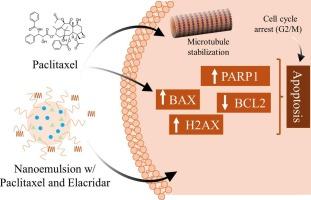紫杉醇-克拉达纳米乳在乳腺癌细胞中的分子效应:对摄取、细胞周期和信号通路的影响。
IF 4.3
2区 医学
Q1 PHARMACOLOGY & PHARMACY
European Journal of Pharmaceutics and Biopharmaceutics
Pub Date : 2025-08-09
DOI:10.1016/j.ejpb.2025.114837
引用次数: 0
摘要
在这项研究中,我们研究了紫杉醇掺入含有p糖蛋白抑制剂埃拉克里达的生物粘合剂透明质酸修饰纳米乳(NE)中如何影响其在乳腺癌细胞中的分子效应和作用机制。与药物溶液相比,在纳米乳中掺入紫杉醇和埃拉西达导致细胞摄取增加2.5倍。网格蛋白介导的胞吞作用有助于纳米乳介导的细胞内化,紫杉醇和nbd -磷脂酰胆碱(一种纳米乳表面活性剂)与转铁蛋白部分共定位。纳米乳扩增了紫杉醇介导的染色质凝聚和凋亡相关表达蛋白的调节,PARP1 (Poly (adp -核糖)聚合酶1)切割增加2.5倍,BCL2 (b细胞淋巴瘤蛋白2)表达下调1.7倍。细胞凋亡仍然是细胞死亡的主要机制。与浓度低于IC50的溶液相比,该配方还减少了细胞迁移(3倍),而克隆效应(17倍)没有受到阻碍,支持对肿瘤发生的更广泛影响。本文章由计算机程序翻译,如有差异,请以英文原文为准。

Molecular effects of paclitaxel-elacridar nanoemulsions in breast cancer cells: impact on uptake, cell cycle and signaling pathways
In this study, we investigated how paclitaxel incorporation in a bioadhesive, hyaluronic acid-modified nanoemulsion (NE) containing the P-glycoprotein inhibitor elacridar influenced its molecular effects and mechanism of action in breast cancer cells. Incorporation of paclitaxel with elacridar in the nanoemulsion resulted in a 2.5-fold increase in cellular uptake compared to the drug solution. Clathrin-mediated endocytosis contributed to nanoemulsion-mediated cell internalization, with both paclitaxel and NBD-phosphatidylcholine (nanoemulsion surfactant) partially co-localizing with transferrin. The nanoemulsion amplified paclitaxel-mediated chromatin condensation and expression of proteins involved in apoptosis, with a 2.5-fold increase in PARP1 (Poly (ADP-ribose) polymerase 1) cleavage and a 1.7-fold downregulation of BCL2 (B-cell lymphoma protein 2) expression. Apoptosis was maintained as the main mechanism of cell death. The formulation also reduced cell migration (3-fold) compared to the solution at concentrations lower than IC50, while the clonogenic effect (17-fold) was not hindered, supporting a broader impact on tumorigenesis.
求助全文
通过发布文献求助,成功后即可免费获取论文全文。
去求助
来源期刊
CiteScore
8.80
自引率
4.10%
发文量
211
审稿时长
36 days
期刊介绍:
The European Journal of Pharmaceutics and Biopharmaceutics provides a medium for the publication of novel, innovative and hypothesis-driven research from the areas of Pharmaceutics and Biopharmaceutics.
Topics covered include for example:
Design and development of drug delivery systems for pharmaceuticals and biopharmaceuticals (small molecules, proteins, nucleic acids)
Aspects of manufacturing process design
Biomedical aspects of drug product design
Strategies and formulations for controlled drug transport across biological barriers
Physicochemical aspects of drug product development
Novel excipients for drug product design
Drug delivery and controlled release systems for systemic and local applications
Nanomaterials for therapeutic and diagnostic purposes
Advanced therapy medicinal products
Medical devices supporting a distinct pharmacological effect.

 求助内容:
求助内容: 应助结果提醒方式:
应助结果提醒方式:


